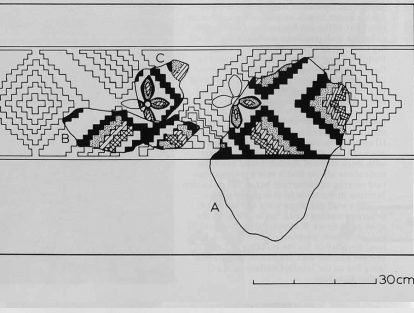In 1971 and 1974 several fragmentary remains of ancient wall paintings were found during the course of excavations at Tall-i Malyan, Iran, dating to the Banesh period around 3200 B.C. (MASCA corrected date). Because building wails in mound sites are not generally preserved to any great height, intact examples of this decorative wall art are quite rare. In prehistoric Iran such remains are virtually unknown, making the Malyan discovery a unique event.
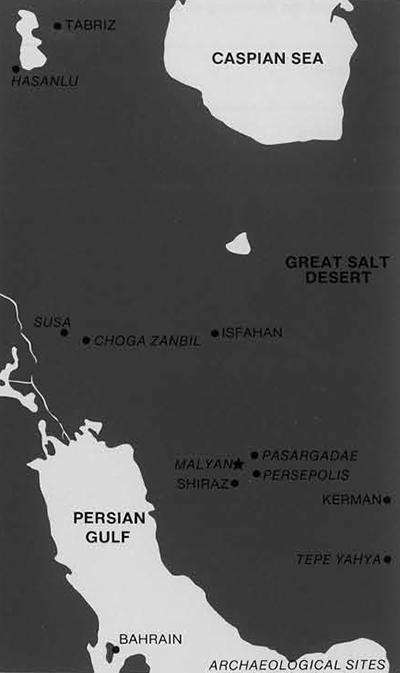
Malyan is located in the Baiza District of Fars Province, Iran, and has been since 1971 the focus of a major excavation program under the joint direction of Robert H. Dyson, Jr. and William M. Sumner. The Project is a joint one of the University Museum and Ohio State University with additional support from the Metropolitan Museum of Art, the National Science Foundation and (in 1976) the National Geographic Society. The site lies 46 kms. north of Shiraz and about the same distance west of Persepolis, and was known in the second millennium B.C. under the name of Anshan, historically identified as the eastern province of the Elamite empire.
Most often, when discovered, the designs of wall paintings must be reconstructed from fragments found in the debris of walls which have either collapsed or which have been deliberately levelled to make way for new construction. The wall paintings of Minoan Knossos are perhaps the most famous of the reconstructions in the Mediterranean area but date hundreds of years after the fragments described here.
At Malyan, the wall paintings were found in one of the three major trenches at the site, designated Operation ABC, which is a 600 square meter trench located in the southwest quadrant of the 200 hectare mound. Specifically, the wall paintings were found in Building Level HI of Operation ABC. In 1971, Building Level III was partially exposed in the southeast corner of the trench. Excavations in 1972 concentrated on Building Level II, and then in 1974 a large area of Building Level III was finally exposed. This level consisted of 17 rooms belonging to one large building. A total of 39 wall-painting fragments were found in 13 of the Building Level III rooms. The building contained at least two rows of large square or rectangular rooms with thick walls of sundried mud brick. Its scale alone shows that it was a major structure serving an important but as yet unknown function in the town of that period.
The wall paintings were not found on existing standing walls, but in pieces in the open room areas. It appears that the Level III walls had been purposely razed to form a level foundation for the building of Level II, and the painted wall fragments were found lying flat on the levelled surface of the earlier structure.
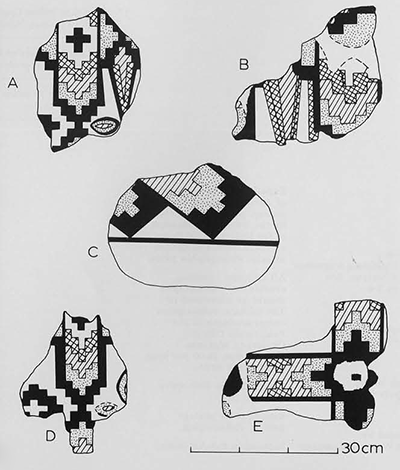
Thirty-two scale drawings were made of the various designs, which are primarily geometric, and for discussion and study purposes are identified as sworl, step, and stripe motifs. Design colors were consistently red, yellow, black and sometimes grey, painted on white plaster which in turn coated a thick tan plaster. When the colored pigments were applied to the wall, the white coating was left in reserve, thus incorporating the white color into the design being created. A preliminary study of the coating, plaster, and pigments using x-ray diffraction phase analysis has been completed by Dr. Tames Blackman, Smithsonian Institution. The tan plaster proves to be a mixture of calcite, dolomite, quartz, and small amounts of clay. The major constituents of the white coating are the same as the plaster except for clay. The pigments have been tentatively identified as hematite for red, limonite for yellow, and carbon for black and grey.
The location of the fragments gave some information as to their original arrangement. The locations were plotted on a 1:50 scale map of Operation ABC Building Level III, which also showed which rooms were painted either red or white. Colors on the fragments and wall colors in the rooms were used as determinants for comparison purposes. However, we could not definitely identify designs as belonging to particular rooms.
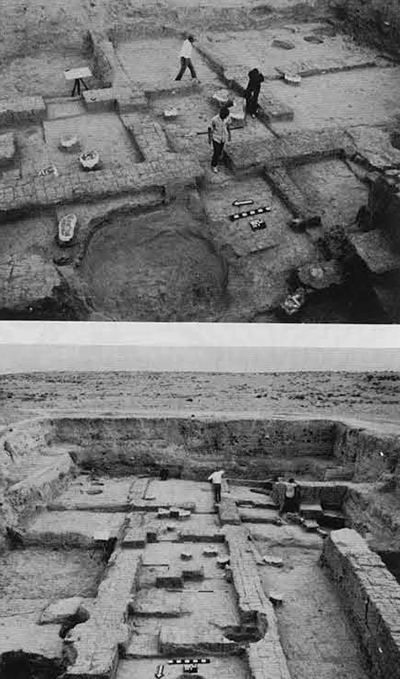
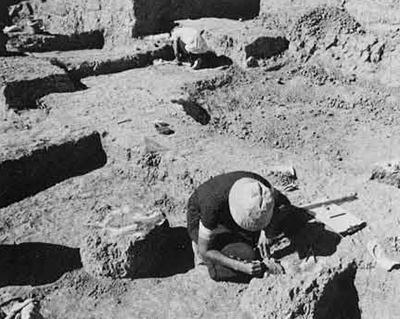
The closest association consisted of several fragments of a stripe design with opposing fields of red and white which were found on top of the west wall of Room 9. These fragments correlated with stripes which were also found on the east face of this wall. The wall surface between the stripes and floor (18 cm.) was painted red. The wall stripes ran parallel to the floor and then turned upwards at the northernmost corner of the wall, indicating that the stripes possibly formed a border for a central white panel, thus explaining the opposing field colors of red and white on the fragments.
Some of the fragments were also drawn in situ showing the orientation of the fragments on the ground. These drawings were to have been used as a possible means of reconstructing how the designs may have been positioned on the walls, but it does not appear that the fragments were left where they fell but were scattered and used as fill to level the area for the preparation of Building Level II architecture.
The study of this problem is continuing with the knowledge that all of the designs found so far have been geometric. This stands in striking contrast to remains found elsewhere in the Near East of fourth millennium date, which more commonly reveal human, animal or floral designs. Aside from the geometric wall patterns formed by the colored wall cones at Warka in southern Iraq and the geometric designs on the polychrome pottery of the Jemdet Nasr pottery of the same area, abstract designs would appear to be characteristic of the southern Iranian plateau in this period, where they occur as far east as Seistan in the form of painted vessels and seal impressions. Indeed, the stepped cross design which occurs in the Malyan wall fragments is a common feature there and in Turkmenia. Similar patterns are also known from Mari far to the west, so that the Malyan paintings, although unique as wall decorations, clearly form part of a much wider world of design which will take considerable further analysis to understand. For the moment, some of the fragments are presented here for the reader’s visual enjoyment and to provoke discussion.
- Plan of Level III in the ABC building at Malyan, showing places where wall painting fragments were found.
- Drawings of wall painting fragments.
- Drawing of wall painting fragments.
- Excavations in the ABC building at Malyan, Level III.



